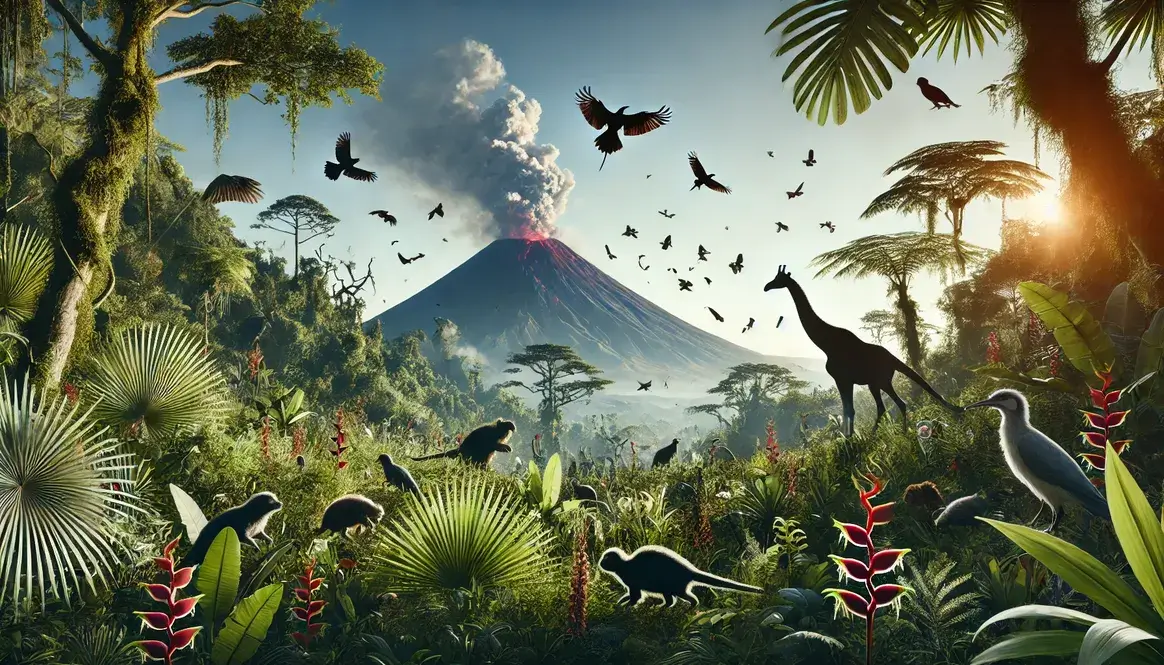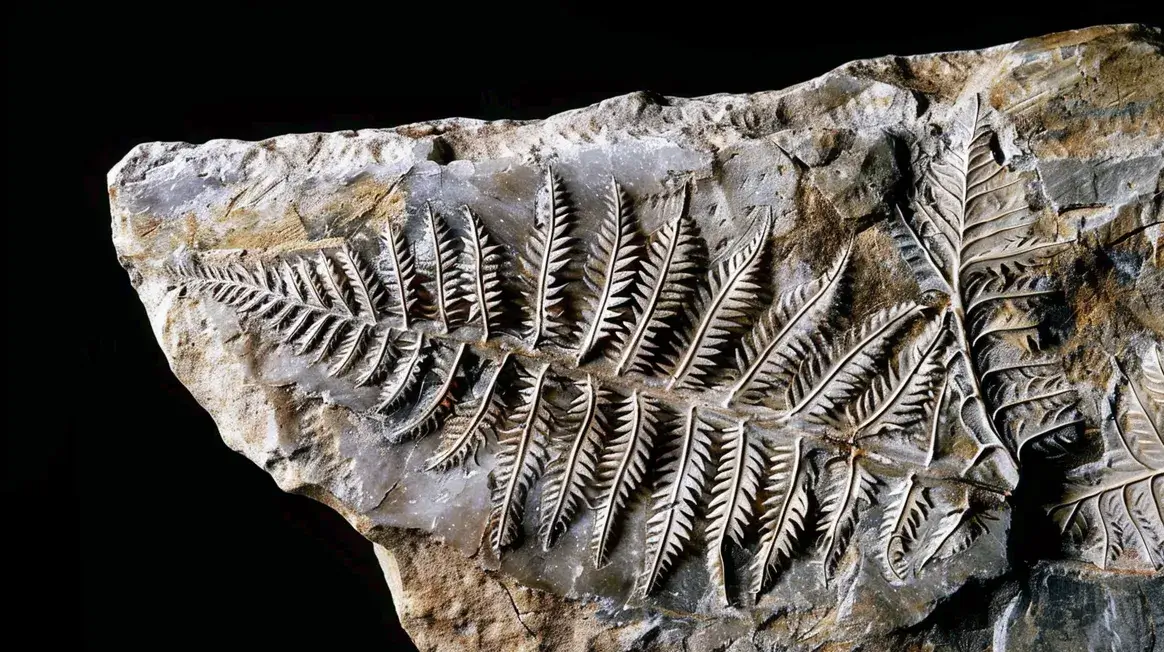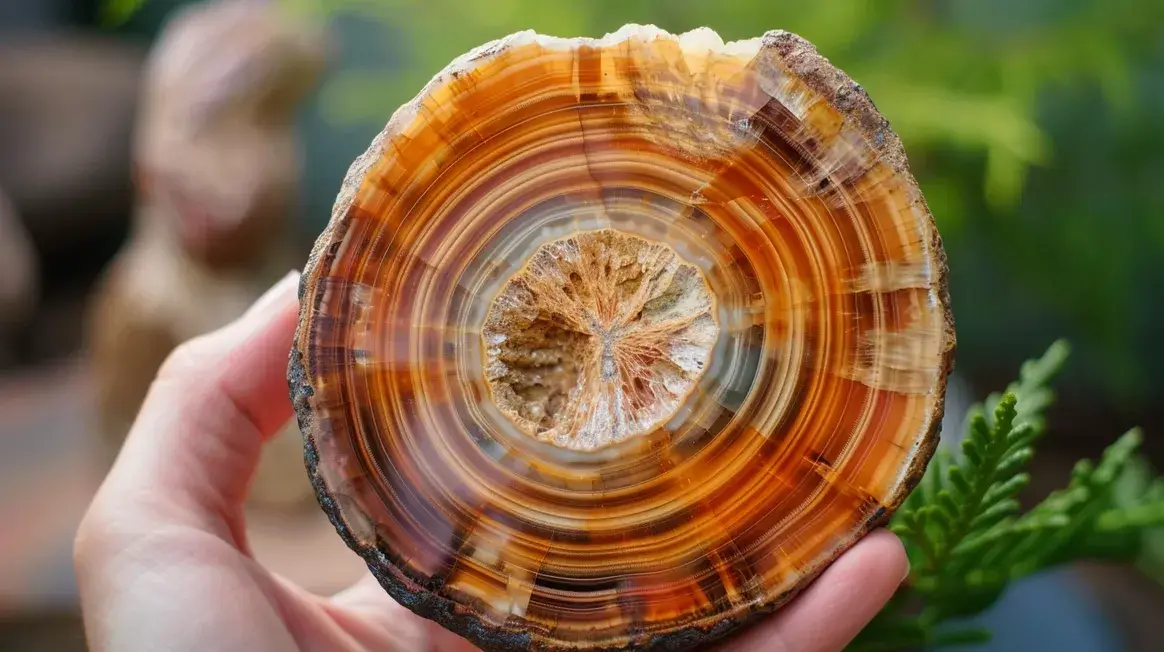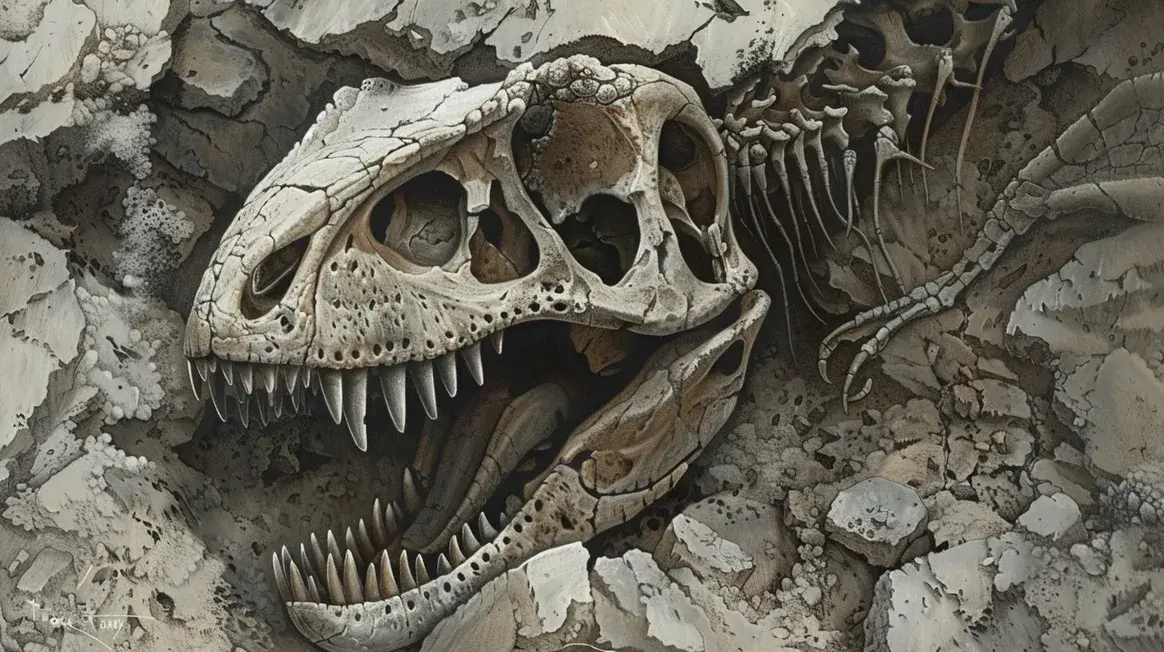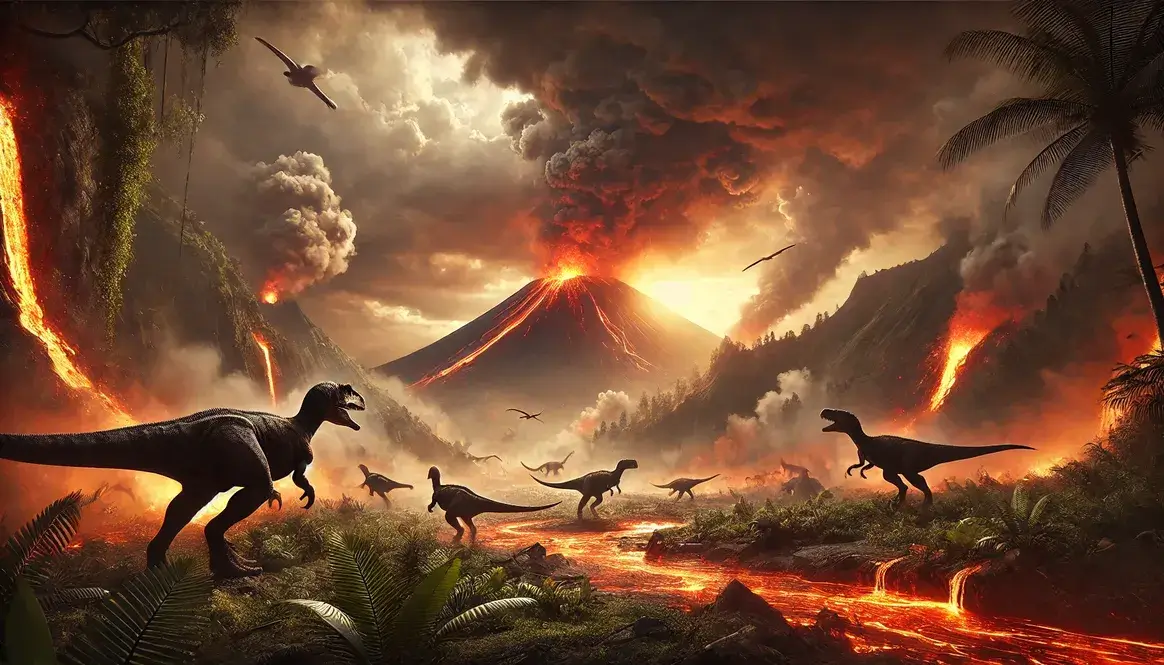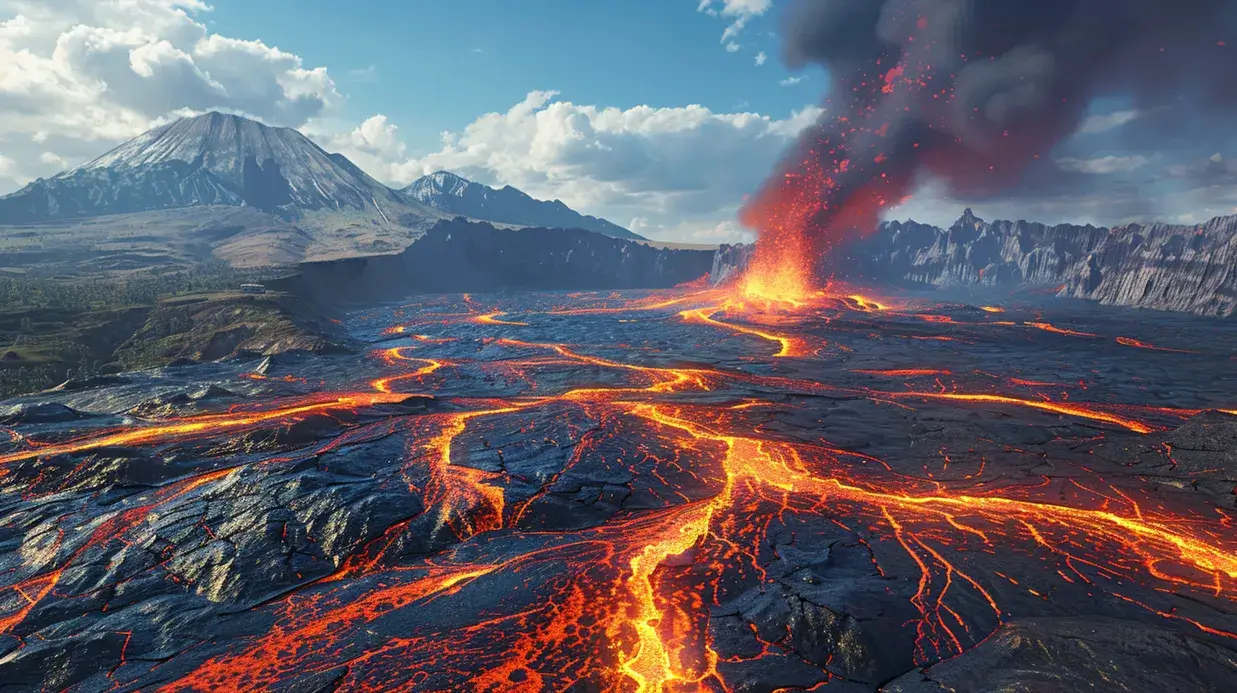Volcanoes are nature’s sculptors, carving out the story of life on Earth with their fiery touch. When we think about how volcanoes affect evolution, we’re looking at a powerful force that has shaped our planet’s biodiversity for millions of years.
These geological giants do more than just spew lava and ash. They’re architects of change, creating new landscapes and challenges that push life to adapt or fade away. It’s a high-stakes game of survival, where species must evolve quickly to keep up with the ever-changing volcanic environment.
In this article, we’ll explore the cause-and-effect dance between volcanoes and evolution. We’ll see how eruptions can lead to the birth of new species, force incredible adaptations, and sometimes reset the evolutionary clock. From the smallest bacteria thriving in hot springs to the rise and fall of dinosaurs, volcanoes have played a key role in writing life’s story.
| Volcanic Effect | Evolutionary Impact |
|---|---|
| Habitat Creation | New species emerge in isolated environments |
| Environmental Stress | Organisms adapt to extreme conditions |
| Mass Extinctions | Surviving species evolve to fill vacant niches |
| Climate Change | Species adapt to new temperature and rainfall patterns |
| Soil Enrichment | Plants evolve to thrive in mineral-rich volcanic soils |
How Volcanoes Affect Evolution: A Powerful Driver of Change
Volcanic activity is like nature’s reset button for evolution. When we talk about how volcanoes affect evolution, we’re looking at a complex interplay of destruction and opportunity. Let’s break down the major ways these fiery mountains shape the course of life on Earth:
- Habitat Creation and Destruction
- Lava flows create new landforms
- Ash deposits alter soil composition
- Eruptions can destroy existing ecosystems
- Environmental Stress
- Heat and toxic gases force rapid adaptation
- Ash clouds can block sunlight, affecting plant life
- Isolation and Speciation
- Volcanic islands become evolutionary laboratories
- Geographic barriers lead to unique adaptations
- Mass Extinctions and Opportunities
- Large-scale eruptions can trigger global extinctions
- Surviving species evolve to fill empty niches
Volcanoes don’t just change landscapes; they reshape the evolutionary playing field. When a volcano erupts, it’s like shuffling the deck of life’s cards. Some species lose big, while others hit the evolutionary jackpot.
Think of it this way: a volcanic eruption might wipe out a forest, but the ash-enriched soil left behind becomes a paradise for plants that can tolerate those conditions. These plants evolve special traits to thrive in this new environment, setting off a chain reaction of evolution as animals adapt to the new plant life.
But it’s not just about what happens on land. Volcanic activity can alter ocean chemistry, leading to changes in marine life. For example, underwater volcanoes can release minerals that fuel the growth of certain microorganisms, shifting the entire food web.
One of the most dramatic ways volcanoes influence evolution is through climate change. Massive eruptions can cool the planet for years, forcing species worldwide to adapt to new temperature patterns. This global shift can lead to widespread evolutionary changes across many species at once.
In essence, volcanoes are nature’s way of keeping evolution on its toes. They create challenges that push life to innovate, adapt, and overcome. It’s a testament to the resilience of life that even in the face of such powerful forces, it not only survives but thrives, spinning out new and incredible forms in response to volcanic influence.
Creating New Habitats: Volcanic Landscapes as Evolutionary Laboratories
Volcanoes are nature’s architects, building new worlds for life to explore and adapt to. These fiery forces create some of the most unique and challenging environments on Earth, serving as natural laboratories for evolution.
Formation of Islands and New Land Masses
Imagine an island rising from the sea, born from the depths of the ocean through volcanic activity. This is how many islands, like the Hawaiian archipelago, came to be. These volcanic islands are perfect examples of how volcanoes shape evolution:
- Isolation: New islands are cut off from the mainland, creating a separate world for species to evolve.
- Unique Conditions: Volcanic soil and climate create special habitats found nowhere else.
- Limited Resources: Species must adapt quickly to survive with what’s available.
The Galápagos Islands, made famous by Charles Darwin, showcase how volcanic island formation leads to incredible biodiversity. Here, we see animals like marine iguanas that have evolved to swim and feed underwater, a trait not found in their mainland cousins.
Rapid evolution on these islands occurs because:
- Small populations can change quickly
- New arrivals face less competition
- Unique environmental pressures drive adaptation
Lava Flows and New Terrestrial Environments
On land, lava flows create a diverse patchwork of new habitats. As lava cools and breaks down, it forms soil rich in minerals but often lacking in other nutrients. This sets the stage for a succession of life forms, each adapting to the changing landscape:
- Pioneer Species: Hardy plants like ferns and lichens are often the first to colonize new lava flows.
- Soil Builders: These early plants help create soil, allowing other species to move in.
- Diverse Ecosystems: Over time, complex communities of plants and animals develop.
A prime example of this process can be seen in Hawaii Volcanoes National Park. Here, you can observe different stages of ecosystem development on lava flows of various ages.
| Lava Flow Age | Dominant Life Forms |
|---|---|
| 0-5 years | Bacteria, algae |
| 5-20 years | Ferns, mosses |
| 20-100 years | Shrubs, small trees |
| 100+ years | Forests, diverse animal life |
The colonization of these new habitats isn’t just about plants. Animals play a crucial role too. Birds might bring seeds to a new lava field, while insects could be the first animals to establish themselves. Each new arrival changes the environment, creating opportunities for further adaptation and evolution.
In essence, volcanoes don’t just destroy – they create. They offer blank slates for life to write new evolutionary stories, showcasing the incredible adaptability of living things in the face of extreme environmental changes.
Adapting to Harsh Conditions: Survival in Volcanic Environments
Volcanic areas are like nature’s extreme sports arenas. They challenge life to its limits, forcing organisms to develop incredible adaptations. Let’s explore how life thrives in these harsh conditions.
Heat-Resistant Organisms
Near volcanoes, temperatures can soar to levels that would cook most living things. Yet, some organisms not only survive but thrive in these scorching environments. These heat-loving creatures, called thermophiles, have evolved amazing ways to beat the heat.
Examples of heat-resistant life forms:
- Bacteria in hot springs: Some bacteria live in waters as hot as 230°F (110°C)!
- Pompeii worms: These deep-sea creatures withstand temperatures up to 176°F (80°C).
- Certain plants: Some plants have adapted to grow on warm volcanic soils.
How do these organisms manage such extreme heat? It’s all about evolutionary adaptations:
- Special proteins: Heat-resistant organisms have proteins that don’t break down at high temperatures.
- Tough cell membranes: Their cell walls are built to withstand heat that would melt normal cells.
- Efficient repair mechanisms: They can quickly fix heat damage to their DNA.
These adaptations didn’t happen overnight. They’re the result of long-term evolutionary processes driven by the harsh conditions near volcanoes.
Acid-Tolerant Species
Volcanic activity often leads to highly acidic environments, both in soil and water. These acidic conditions would dissolve most organisms, but some have evolved to handle the acidity with ease.
Acidic soil adaptations:
- Some plants have developed thick, waxy leaves to protect against acid rain.
- Certain trees can alter the pH of the soil around their roots.
- Fungi often thrive in acidic soils, forming symbiotic relationships with plants.
Acid-loving microorganisms: Believe it or not, some microbes actually prefer acidic conditions. These acidophiles have evolved unique ways to maintain their internal pH balance even when surrounded by acid.
| Organism | pH Tolerance | Habitat |
|---|---|---|
| Ferroplasma acidiphilum | As low as 0 | Acid mine drainage |
| Dunaliella acidophila | 0-3 | Acidic lakes |
| Cyanidium caldarium | 0-4 | Hot sulfur springs |
These acid-tolerant species play a crucial role in volcanic ecosystems. They’re often the first to colonize new volcanic areas, paving the way for other life forms to follow.
The ability of life to adapt to such extreme conditions shows the incredible power of evolution. It’s a testament to life’s resilience and creativity in the face of challenges posed by volcanic environments. These adaptations not only allow organisms to survive but also open up new evolutionary pathways, contributing to the biodiversity we see on Earth today.
Mass Extinctions and Evolutionary Opportunities
Volcanoes don’t just shape individual species; they can reshape entire ecosystems and even influence the course of life on Earth. Let’s explore how these fiery giants can cause mass extinctions and, paradoxically, create new opportunities for life to flourish.
Volcanic-Induced Extinctions
Massive volcanic eruptions have been linked to some of the most devastating extinctions in Earth’s history. These events can trigger a cascade of environmental changes that many species simply can’t survive.
One of the most notable examples is the end-Cretaceous extinction, which wiped out the non-avian dinosaurs. While an asteroid impact is often cited as the main cause, the massive volcanic eruptions of the Deccan Traps in India likely played a significant role too. These eruptions released enormous amounts of gases and particles into the atmosphere, leading to:
- Global cooling (volcanic winter)
- Acid rain
- Ocean acidification
- Changes in plant communities
But it’s not just the big, famous extinctions. Smaller-scale volcanic events can also cause local or regional extinctions, reshaping ecosystems on a smaller but still significant scale.
Recovery and Diversification
While extinctions are devastating, they also create opportunities. When dominant species disappear, it opens up niches for survivors to evolve and diversify. This process can lead to rapid evolutionary change and the emergence of new species.
After a volcanic-induced extinction event, we often see patterns like:
- Rapid adaptive radiation: Surviving species quickly evolve to fill empty niches.
- Novel adaptations: New environmental conditions drive the evolution of unique traits.
- Ecosystem restructuring: New species interactions emerge as ecosystems rebuild.
A fascinating case study of post-extinction recovery is the aftermath of the end-Permian extinction, often called “The Great Dying.” This extinction, linked to massive volcanic activity in Siberia, wiped out about 95% of marine species and 70% of terrestrial vertebrate species.
In the wake of this catastrophe:
- Surviving reptile groups evolved into a wide array of new forms, including the ancestors of dinosaurs.
- In the oceans, modern reef ecosystems began to take shape as new groups of organisms filled the roles of extinct reef-builders.
- Plants adapted to the changed climate, with some groups like conifers becoming more dominant.
This table illustrates the dramatic shifts in dominant animal groups before and after the end-Permian extinction:
| Before Extinction | After Extinction |
|---|---|
| Synapsids (mammal ancestors) | Archosaurs (dinosaur and crocodile ancestors) |
| Amphibians | Early reptiles |
| Trilobites | Crustaceans |
These examples show how volcanic activity, while destructive, can be a powerful driver of evolutionary change. By clearing the stage, so to speak, volcanoes allow for new evolutionary experiments to unfold, ultimately contributing to the rich tapestry of life on Earth.
Volcanoes and Dinosaur Evolution: A Fiery Relationship
The age of dinosaurs was marked by significant volcanic activity, which played a crucial role in shaping the world these magnificent creatures inhabited. Let’s explore how volcanoes influenced dinosaur evolution and potentially contributed to their demise.
Volcanic Activity During the Mesozoic Era
The Mesozoic Era, often called the Age of Dinosaurs, was a time of intense geological activity. Volcanic eruptions were common, and they had far-reaching effects on the dinosaurs’ world.
Major volcanic events during this time included:
- Central Atlantic Magmatic Province (CAMP): This massive eruption occurred at the end of the Triassic period, coinciding with a major extinction event that may have paved the way for dinosaur dominance.
- Karoo-Ferrar Eruptions: These eruptions in the early Jurassic period likely caused significant climate changes, affecting dinosaur habitats globally.
- Paraná and Etendeka Traps: These large igneous provinces formed in the early Cretaceous, potentially influencing dinosaur distribution and evolution.
These volcanic events shaped dinosaur habitats in several ways:
- Climate Changes: Volcanic eruptions released greenhouse gases, leading to periods of global warming. This affected plant life and, consequently, herbivorous dinosaurs and their predators.
- Landscape Alterations: Lava flows created new terrains, forcing dinosaurs to adapt or migrate.
- Atmospheric Effects: Ash and gases from eruptions could have caused short-term cooling and altered rainfall patterns, challenging dinosaur adaptability.
The Deccan Traps and Dinosaur Extinction
The Deccan Traps eruptions in India represent one of the largest volcanic events in Earth’s history. These eruptions coincided with the end-Cretaceous extinction event that wiped out the non-avian dinosaurs.
The role of the Deccan Traps in dinosaur extinction is a subject of ongoing debate among scientists. Here’s a breakdown of the key points:
Evidence for Volcanic Influence:
- The eruptions released massive amounts of carbon dioxide and sulfur dioxide, potentially causing global climate changes.
- Volcanic activity may have weakened ecosystems over time, making them more vulnerable to sudden changes.
Asteroid Impact Theory:
- Many scientists believe an asteroid impact was the primary cause of dinosaur extinction.
- The impact could have triggered global wildfires, tsunamis, and a prolonged “impact winter.”
The Debate: Some researchers argue for a “one-two punch” hypothesis:
- Deccan Traps eruptions stressed global ecosystems over thousands of years.
- The asteroid impact delivered the final blow, causing mass extinction.
Others suggest that the Deccan Traps alone could have caused the extinction, with the asteroid impact being a contributing factor.
This table summarizes the potential effects of both volcanic activity and asteroid impact:
| Factor | Volcanic Activity | Asteroid Impact |
|---|---|---|
| Timeframe | Long-term (thousands of years) | Sudden (days to years) |
| Climate Effect | Gradual warming, then cooling | Rapid, severe cooling |
| Geographic Scope | Global, but variable | Global, uniform |
| Direct Damage | Localized to eruption area | Widespread destruction at impact site |
The relationship between volcanoes and dinosaur evolution is complex and fascinating. While volcanic activity helped shape the world dinosaurs lived in throughout the Mesozoic, it may have also played a role in their ultimate extinction. This demonstrates the profound influence that volcanic processes can have on the course of evolution over millions of years.
Modern Examples: Observing Volcano-Driven Evolution Today
While much of what we know about how volcanoes affect evolution comes from studying the past, we can also observe these processes happening in real-time. Modern volcanic environments provide us with living laboratories to study rapid adaptation and ongoing evolutionary changes.
Rapid Adaptation on Volcanic Islands
Young volcanic islands offer a unique opportunity to witness evolution in action. These isolated environments, with their challenging conditions, drive species to adapt quickly or perish.
One fascinating example is Surtsey, a volcanic island that emerged off the coast of Iceland in 1963. Scientists have been studying the colonization and evolution of life on Surtsey since its formation. Here’s what they’ve observed:
- Plant Colonization: Within a few years of the island’s formation, seeds carried by wind and sea began to sprout. By 2008, 69 plant species had established themselves on the island.
- Insect Adaptation: Spiders and insects arriving on Surtsey have shown rapid changes in body size and coloration to better suit the barren, volcanic environment.
- Bird Evolution: Seabirds nesting on the island have influenced soil development, creating more hospitable conditions for other organisms.
Another striking example comes from the Galápagos Islands, where ongoing volcanic activity continues to shape evolution. Recent studies have shown:
- Darwin’s Finches: These birds, famous for their role in Darwin’s theory of evolution, continue to adapt rapidly to changing conditions on the islands. For instance, researchers observed significant changes in beak size and shape in a population of ground finches in just two generations, following a severe drought.
- Galápagos Giant Tortoises: Different populations of these tortoises have evolved distinct shell shapes based on the volcanic landscapes of their home islands. Tortoises on islands with more vegetation have dome-shaped shells, while those on islands with sparse vegetation have saddle-shaped shells that allow them to reach higher for food.
Lessons from Volcano-Adjacent Ecosystems
Studying ecosystems near active volcanoes provides valuable insights into how life adapts to extreme and ever-changing environments. These areas serve as natural experiments in evolution.
Research on Mount Etna in Sicily has revealed:
- Plant Adaptations: Some plants growing on the volcano’s slopes have developed resistance to high levels of heavy metals in the soil, a trait not seen in the same species growing elsewhere.
- Insect Evolution: Certain dark-colored moths living on Mount Etna’s lava flows have evolved to be darker than their counterparts in non-volcanic areas, providing better camouflage against the black lava.
Near the active volcanoes of Hawaii, scientists have observed:
- Rapid Plant Speciation: The Hawaiian silversword alliance, a group of plants, has diversified into over 30 species in just 5 million years, adapting to various volcanic habitats.
- Lava Tube Ecosystems: Unique communities of organisms have evolved to live in the dark, humid environments of lava tubes, showcasing how volcanic features can create novel evolutionary pathways.
These modern examples demonstrate that volcanic activity continues to be a powerful driver of evolution. By studying these ongoing processes, we gain valuable insights into how life responds to environmental challenges, helping us better understand both past and future evolutionary trends.
The Long-Term Impact: Volcanoes as Shapers of Life’s History
As we’ve explored throughout this article, volcanoes have played a crucial role in shaping the evolution of life on Earth. Their impact stretches far beyond the immediate destruction caused by eruptions, influencing the very course of life’s history over millions of years.
Let’s summarize the diverse ways volcanoes influence evolution:
- Habitat Creation and Destruction Volcanoes are nature’s architects, building new islands and reshaping existing landscapes. This process creates opportunities for species to colonize new areas and adapt to novel environments. At the same time, volcanic activity can destroy habitats, forcing organisms to either adapt or face extinction.
- Climate Modulation Volcanic winter effects can lead to global cooling, while greenhouse gases from eruptions can cause long-term warming. These climate shifts drive evolutionary adaptations across ecosystems worldwide.
- Speciation Catalyst Volcanic islands, in particular, serve as evolutionary laboratories. The isolation and unique conditions of these environments accelerate the process of speciation, leading to the emergence of new, specialized life forms.
- Mass Extinctions and Rebounds Major volcanic events have been linked to mass extinctions throughout Earth’s history. While devastating, these events also create opportunities for surviving species to diversify and fill newly vacated ecological niches.
- Soil Enrichment Volcanic ash and lava break down over time, creating nutrient-rich soils. This process influences plant evolution and, by extension, the animals that depend on those plants.
- Extreme Environment Adaptation The harsh conditions near volcanoes, such as high temperatures and acidic soils, drive the evolution of extremophiles – organisms adapted to live in conditions that would be lethal to most life forms.
Volcanoes have been constant companions in life’s journey on Earth. From the earliest microbes to the complex ecosystems of today, living things have had to reckon with the challenges and opportunities presented by volcanic activity. This ongoing relationship has pushed life to innovate, adapt, and diversify in remarkable ways.
Consider the following table, which illustrates some key evolutionary outcomes driven by volcanic influences:
| Volcanic Influence | Evolutionary Outcome | Example |
|---|---|---|
| Island Formation | Adaptive Radiation | Darwin’s Finches |
| Climate Change | Migration and Adaptation | Mammal Evolution after K-Pg Extinction |
| Soil Chemistry | Plant Specialization | Metal-tolerant Plants on Volcanic Soils |
| Habitat Isolation | Speciation | Endemic Species on Hawaii |
In conclusion, volcanoes are not just destructive forces; they are dynamic shapers of life’s evolutionary path. By creating challenges and opportunities, they have spurred life to greater diversity and resilience. As we continue to study these processes, we gain deeper insights into the intricate relationship between Earth’s geological forces and the ever-evolving tapestry of life on our planet.

